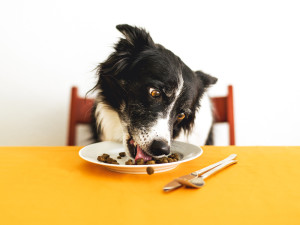
share article
If you have a pup that loves to chew, you’ve probably combed the pet aisles looking for enticing substitutes for your laptop cord and chair leg. Among the piles of dog toys, the knuckle and femur bones, one pet store mainstay is the rawhide aisle.
Promoted as an ‘all-natural’ treat, rawhides keep dogs entertained, perhaps even more so when in its many basted, twisted, even brightly coloured mutations. It’s the equivalent of that marshmallow-filled cereal made with real oats that kids howl for all the way down the cereal aisle. Your dog would like to convince you that rawhide is primal therapy for their carnivorous soul. But the closer you look at how rawhides are produced and the risks associated with them, the more you may want to wean your pup off this dubious by-product.
If rawhide manufacturers were held to the same standards as drug makers, they’d be forced to add an equally long list of warnings to their labels: rawhides may cause stomach torsion, choking, vomiting, diarrhoea and salmonella poisoning.
Disclaimer: While rawhide bones are good for cleaning your pup’s teeth, the risks to their health and safety far outweigh the benefits. Read on for more information.
Six dangers of rawhides for dogs
1. Rawhides are made with toxic chemicals
The Animal and Plant Health Agency has protocols regulating how dog chews made from animal by-products are treated, tested and packaged to avoid bacterial contamination. But that doesn’t protect your pet from harmful chemicals used during the production process.
Producing rawhide begins with splitting an animal hide, usually from cattle. The top grain is generally tanned and made into leather products, while the inner portion, in its ‘raw’ state, goes to the dogs. Removing the hair from hides often involves a highly toxic recipe: sodium sulphide liming. A standard practice is to procure rawhide in the ‘split lime state’ as by-products from leather tanneries.
Along the way, various chemicals are used to slow down the rate of decay of the animal skin. In the post-tannery stage, hides are washed and whitened using a solution of hydrogen peroxide to get rid of the rotten stench. They may even be coated with titanium oxideopens in a new tab to make them appear whiter. And that’s not all: other poisonous residues that may show up in rawhide include lead, arsenic, mercury and formaldehyde.
2. The flavourings may contain carcinogens
Over the last decade, there has been an explosion of patents for flavoured rawhide hitting the market, from bubblegum to hickory. However, in creating treats pups will chomp for hours, companies also produced potentially more toxic products. The more dogs lick, chew and swallow the material, the greater their exposure to any contaminants it contains.
In the case of bubblegum flavouring, the Material Safety Data Sheet revealed a toxic confection containing Allura Red AC dye, which is thought to be carcinogenic, along with preservatives like sodium benzoate. But tracking the effects of chemical exposure is nearly impossible when it’s a matter of slow, low-dose poisoning.
3. Rawhides are not digestible
Being a by-product of the leather industry, traditional rawhides are chemically engineered to make them tough and durable, but those same qualities make them hazardous to a dog’s health. Rawhide chews are consumable, but that doesn’t necessarily mean they are digestible. “Most commonly, they swallow things that are too big to pass and end up stuck in the oesophagus, stomach or intestines,” says Dr James Barr, assistant professor at the Texas A&M College of Veterinary Medicine & Biomedical Sciencesopens in a new tab.
While a dog can happily chow down on a rawhide, softening it, they ultimately only break it down into smaller chunks. Those tough non-digestible pieces are swallowed whole and do not break down. Instead, the rawhide swells within a dog’s stomach, making it difficult to pass. At best, rawhides can cause a minor stomach ache and, at worst, cause a life-threatening obstruction in the gut.
4. Dogs can choke on rawhide
Another risk associated with rawhides is biting off more than they can chew – literally. So, if a dog tries to swallow a chunk of rawhide that is too big, the piece may end up stuck in the oesophagus, causing them to choke.
“The most common thing that causes actual choking in dogsopens in a new tab are dog treats like rawhides that can be swallowed,” says Dr Barr. “Bones and rawhides to a dog that chews them well pose little threat, but dogs that want to quickly ingest their treats are the ones most likely to get things stuck in their throat. Though it’s too big to swallow, they try anyway.” Even if a pup properly chews their food before swallowing, accidents can happen.
5. Teeth fractures are common
While not exclusive to rawhides, these chews can cause significant tooth damage. According to Dr Nadine Fianiopens in a new tab, Associate Clinical Professor at Cornell University’s School of Veterinary Medicine, chewing on hard objects, like rawhide, is actually the most common cause of tooth fractures.
Puppies and aggressive chewers are more likely to experience a fracture because they lack inhibition. Not only can a fractured tooth be painful for pups, but it leaves the door open to a secondary infection, which can spread to other areas of the body.
6. Grim connections to the dog meat trade
With rawhide produced in Asia, there’s no knowing what it’s made from. Even dog skin is a possibility. In some areas of Asia, the dog trade is widely prevalent, with tens of millions of dogs being slaughtered each year for their meat and fur.
An investigation in the late ’90s of the fur trade by Humane Society International resulted in this informationopens in a new tab: “In a particularly grisly twist, the skins of brutally slaughtered dogs in Thailand are mixed with other bits of skin to produce rawhide chew toys for pet dogs. Manufacturers told investigators that these chew toys are regularly exported to and sold in US stores.”
Healthy alternatives to rawhides
When it comes to rawhide chews, the most important thing to remember is to always supervise your dog and remove any small pieces. For healthy alternatives to rawhide for your dog, consider using veggies such as carrotsopens in a new tab, frozen Kongsopens in a new tab, free-range chews, bully sticks, Himalayan chews or organic raw bones. If you do choose rawhides, look for those free of toxic preservatives and chemicals that are dried naturally.
Sheila Pell
Sheila Pell is a freelance journalist who frequently writes about environmental issues. Her work has appeared in The Washington Post, Modern Farmer, San Diego Reader, The Bark, and American Forests. She lives in northern California with her husband and two large dogs.
Related articles
![Labrador retriever licking their lips]() opens in a new tab
opens in a new tabWhy Do Dogs Eat Poo?
What to do when your dog has questionable tastes
![A calico tabby kitten chewing and tearing a roll of toilet tissue.]() opens in a new tab
opens in a new tabWhy Does My Cat Chew On Everything?
How to decode your cat’s chewing habits when they’re nibbling on all the things
![A person giving a banana to a dog.]() opens in a new tab
opens in a new tab10 Fruits and Vegetables That Your Dog Can Feast On
Indulge your dog (safely) with these delicious and healthy snacks
![Border Collie digging into a plate of dog food while seated at a yellow table]() opens in a new tab
opens in a new tabHow You Can Easily Manage Your Dog’s Weight
Keep your pup’s weight down, and you could add years to their life. What’s better than that?



